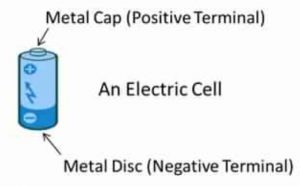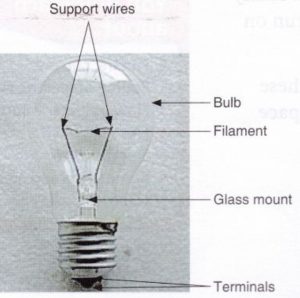Electricity – Class 6, Electricity and Circuits
Question 1 State few appliances used in everyday life which work with electricity?
Question 2 State any two dangers of electricity if handles carelessly?
Question 3 State few uses of electricity?
Question 4 Name few gadgets which use electricity for their working?
Question 5 Explain why we should never join the two terminals of a cell by wire only?
Question 6 Draw the sketch of a torch bulb?
Question 7 What is a dry cell? Explain the construction of dry cell?
Question 8 Which part of the torch bulb gives off light when it is connected to a cell by wires?
Also Read NCERT Solutions for Chapter 12 Electricity and Circuits
Electricity
Electricity is useful because it can be converted easily into various other forms of energy such heat energy, light energy, mechanical energy, sound energy and magnetism. We use electricity to run many appliances in our day to day life which makes our work easier.
For example:
(1) At the touch of a switch, we can make an electric bulb glow and produce light.
(2) Electricity is used to run fans, coolers and air conditioners which make our life cool and comfortable during hot summer days.
(3) The refrigerator in our homes also works with electricity.
(4) Electricity is also utilised in a room heater which keeps us warm on a cold winter day.
(5) Electricity is used to operate water pumps in our homes which lift water from ground level to the rooftop tank.
(6) Electricity is used to pump underground water from tube wells for irrigation in field.
(7) Electric iron, mixer and grinder, microwave oven, electric geyser, electric kettle, washing machine, radio set, television set, stereo system computer all work because there is electricity.
(8) Electric trains runs with electricity.
(9) Power plant station produce electricity.
Electricity can also be very dangerous
If electric wires and electrical appliances are handled carelessly, then a person can get electric shock which may cause severe burns and even death.
Improper handling of electricity can also cause fires. A danger sign is usually displayed on electric poles, electric substations, electric transformers and many other places to warn the people that they should not come in contact with them because electricity can be very dangerous.
We should never use electricity from power points or sockets in our homes or school for performing science experiments because it is very unsafe and dangerous to do so.
We can use an electric cell to get electricity that is safe for performing experiment. An electric cell is known as dry cell or cell.
A cell provides much less electricity than that provided by power stations. A single electric cell usually provides only 1.5 volts of electricity whereas the electricity from power plants which is used in our homes is 220 volts.
If two or more cells are joined together, they make a battery. Cells and batteries are available in the market in different shapes and sizes depending on their use. In order to get electricity from a cell or battery we have to connect it into a circuit.
Electric Cell

An electric cell is a device which produces a small amount of electricity.
Electric cell is a source of safe electricity as well as portable electricity.
Dry Cell
The electric cell which we use in torch is known as dry cell. It is called dry cell because it does not contain any liquid chemical.
The electric cell is a cylindrical device having a small metal cap on one side and a metal disc on the other side.
The electric cell has two terminals: a positive terminal and negative terminal. The metal cap is positive terminal of the electric cell whereas metal disc is the negative terminal of the electric cell.
The positive terminal of electric cell is marked plus (+) and the negative terminal of the electric cell is marked minus(-).
The electric cell produces electricity from the chemicals stored inside it. When all the chemicals in the electric cell are used up, the electric cell stop producing electricity. Ordinary electric cells cannot be recharged.
The electric cells or batteries used in cars, cameras, mobile phones can be recharged again and again for many years.
Electric cells are used as a source of electricity in torches, wristwatches, alarm clocks, transistor, radios, TV remotes, cameras, mobile phone, toys and many other devices.
In experiments we should always join the two terminals of a cell by connecting them through wires containing a device such as a torch bulb and a switch. We should never join the two terminals of a cell directly by a wire because if we join the two terminals of a cell directly by wire only, then the chemicals present in the cell get used up very fast, the cell gets damaged quickly.
Torch bulb

The small electric bulb which produces light when a torch is switched on is called a torch bulb.
(1) The torch bulb consists of a small glass bulb fixed on a metal case. Inside the glass bulb, there is a very thin wire fixed between two thick wire.
(2) The thin wire inside the body is called filament of the bulb. Filament is usually made of very thin tungsten wire. It is the filament of the bulb which glows when electricity from cell is passed through it.
(3) The two thick wires inside the glass bulb provides support to the filament and also make the connection of the filament to the outer circuit.
(4) The lower end of one of the thick wire is connected to the metal tip at the bottom of the bulb whereas the lower end of the other thick wire is connected to the metal case of the bulb.
(5) The metal tip at the base of the bulb and the metal case of the bulb are the two terminals of the torch bulb. So, a torch bulb has two terminals. The two terminals of a torch bulb do not touch each other, they are separated by an insulating material between them.
Metal case of the torch bulb is shaped like a screw so that it can be fixed in the bulb holder.
Working
When the two terminals of a cell are connected to the two terminals of a torch bulb by using wires, the electric current passes through the filament of the bulb and it starts glowing. The torch bulb lights up when its metal tip and metal case are connected to a cell through wires. When electricity or electric current from the cell passes through the filament of the bulb, the filament gets heated too much. The filament becomes white hot and starts giving light. It is the heating effect produced by the electricity from the cell which makes a torch bulb works and produce light. A torch bulb converts electricity into light.
An electric bulb has a filament which is connected to the two terminals. The electric bulb glows when electric current passes through its filament. The small amount of electricity produced by one or two dry cells can light up only a small electric bulb like a torch bulb, it cannot light up the big electric bulb which we use for lightning in our house.
Electric wires have a plastic insulation over them. In order to use electric wires in electric circuits, some of the insulation from both ends each piece of wire has to be removed to get bare wires for making connections. The bare ends of electric wires can be connected to the two terminals of a cell by using rubber bands or adhesive tapes used by electricians. The electric wires can be connected to the two terminals of a torch bulb by using adhesive tapes.
Notes for Chapter 12 Electricity and Circuits
- Electricty
- Circuits
- Conductors and Insulators
Share with Friends















![Toni Kroos là ai? [ sự thật về tiểu sử đầy đủ Toni Kroos ]](https://evbn.org/wp-content/uploads/New-Project-6635-1671934592.jpg)


